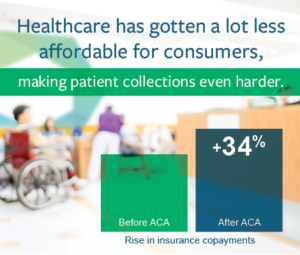Bad Debt Doesn’t Have to Get Worse for Health Systems
If providers are able to adapt to a different collections model
 Even with current “best practices,” health systems collect less than 35% of patient financial liabilities. Trends in the healthcare industry have shifted greater financial liability onto the patient. The ACA and rising prevalence of high-deductible plans have increased patient copayments by 34%. As patients are unlikely to pay medical bills above 5% of their annual income, health systems will see patient bad debt rise and revenue shrinks—unless they recalibrate their strategies for collections.
Even with current “best practices,” health systems collect less than 35% of patient financial liabilities. Trends in the healthcare industry have shifted greater financial liability onto the patient. The ACA and rising prevalence of high-deductible plans have increased patient copayments by 34%. As patients are unlikely to pay medical bills above 5% of their annual income, health systems will see patient bad debt rise and revenue shrinks—unless they recalibrate their strategies for collections.
The current approach is the heart of the problem; despite the fact that patient transactions have become increasingly critical to revenue, health system collection processes continue to be optimized for handfuls of large insurers—not thousands of individual people. With the right methodologies, smart health systems can do better than survive in the current healthcare landscape—they can thrive.
Look to consumer-driven industries for inspiration: setting expectations, clarifying billing, harnessing preferred communication methods, utilizing customer relationship technology, and prioritizing the overall financial experience for consumers.
Consumers appreciate transparency—they reward those who offer it with repeat business, positive online reviews, and direct referrals. But healthcare suffers from opacity. In no other industry does the customer willingly agree to pay for a service without knowing up front what the end costs will be. Yet, it is typical in healthcare, and patients ultimately make providers pay for the confusion.
For example, when providing a patient with an estimate, explaining how the estimate could change and offering proactive payment plans enhances customer relationships. This level of service does more than set financial expectations—it clarifies the patient/provider/insurer relationship and builds trust. Patients with a comprehensive understanding of their financial responsibilities are far more likely to pay their bills.
Redefining “best practices” for collections is the first step toward lower debt and higher revenue. Sirono is always working to increase patient payments for health systems. Sign up for our mailing list to receive alerts on future blog and social posts, white papers and webinars that will show a more profitable approach to collections. But if waiting isn’t an option, please contact us today.
Managed Healthcare Executive, ACA Drives 34% Increase in Copayments, Coinsurance, 2014, by Tracy Walker, found here: http://managedhealthcare executive.modernmedicine.com/managed-healthcare-executive/content/ tags/aca/aca-drives-34-rise-copayments-coinsurance?page=full
Becker’s Hospital CFO, Bad Debt on the Rise for Hospitals Nationally: 4 Takeaways, 2016, by Brooke Murphy, found here: http://www.beckershospitalreview.com/finance/bad-debt-on-the-rise-for-hospitals-nationally-4-takeaways.html
SaveSave




